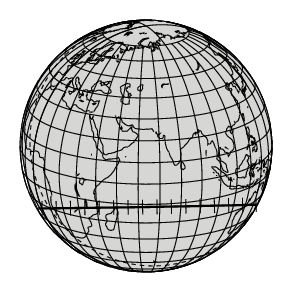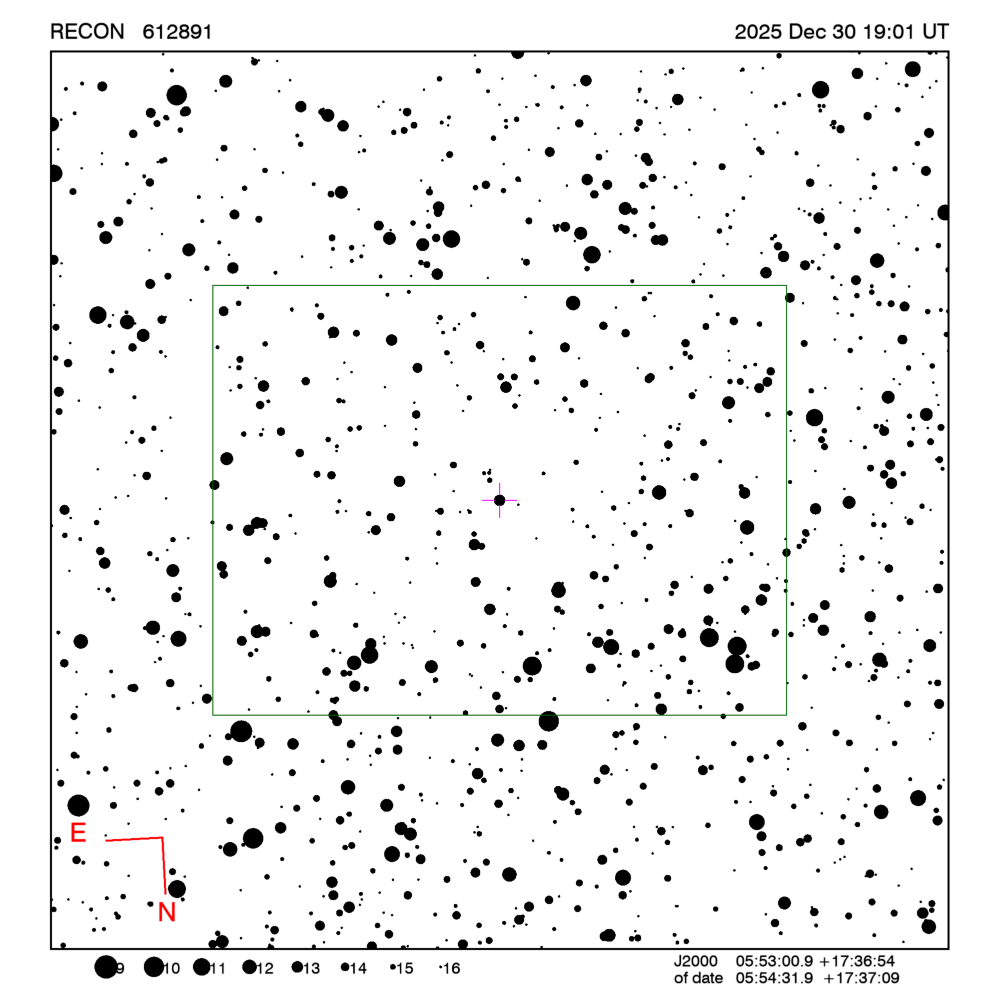RECON: TNO occultation with 612891
Event between (612891) 04TT357 and star GA1060:01458406
with event index number of 2804600
Geocentric closest approach at 2025/12/30 19:00:50 UTC
J2000 position of star is 05:53:00.9 +17:36:54
Equinox of date position of star is 05:54:19.1 +17:37:07
Stellar brightness G=13.2,
use SENSEUP=32 with the MallinCam and and exposure
time of 500 milli-seconds with the QHY174 camera.
Star is 41 degrees from the moon.
Moon is 82% illuminated.
TNO apparent brightness V=23.3
 TNO is 34.5 AU from the Sun
and 33.6 AU from the Earth.
TNO is 34.5 AU from the Sun
and 33.6 AU from the Earth.
The TNO is moving 24.0
km/sec on the sky relative to the star, or,
3.5 arcsec/hr.
The 1-sigma error in the time of the event is 355 seconds.
The 1-sigma cross-track error in the shadow position is
1673 km.
The TNO has an absolute magnitude Hv=7.9
Diameter=157.8 km assuming a 5% albedo -- 6.6 sec chord
Diameter=64.4 km assuming a 30% albedo -- 2.7 sec chord
Dynamical classification is 5:2EEE
Star training set for 612891, (2025/12/30 19:01UT)
Object RA Dec mag sep mel
Betelgeuse 05:56:34.8 +07:24:35 0.4 10.22 45
Alhena 06:39:12.8 +16:22:29 1.9 10.75 52
57 Ori 05:56:29.0 +19:45:08 5.6 2.18 41
PPM 121583 05:56:29.3 +17:24:17 8.3 0.51 41
PPM 121489 05:52:47.7 +17:20:24 9.8 0.50 41
PPM 121543 05:55:03.9 +17:52:08 10.1 0.28 41
612891 05:54:31.9 +17:37:09 13.2 41
Positions are for equinox of date

Azimuth is measured in degrees eastward from north.
North is at an azimuth of 0, due East is at an azimuth
of 90 degrees, due South is 180, and due West is 270.
Do not use the listing below for the RECON CPC 1100 telescopes.
This is provided for other non-team facilities.
Star training set for 612891, (2025/12/30 19:01UT)
Object RA Dec mag sep mel
Betelgeuse 05:55:10.3 +07:24:26 0.4 10.22 45
Alhena 06:37:42.8 +16:23:56 1.9 10.75 52
57 Ori 05:54:56.6 +19:44:58 5.6 2.18 41
PPM 121583 05:54:58.5 +17:24:07 8.3 0.51 41
PPM 121489 05:51:16.9 +17:20:06 9.8 0.50 41
PPM 121543 05:53:32.8 +17:51:55 10.1 0.28 41
612891 05:53:00.9 +17:36:54 13.2 41
Positions are for J2000
Event circumstances last updated at 2022/05/04 23:11:45 UT
Marc W. Buie,
Southwest Research Institute
RECON
 TNO is 34.5 AU from the Sun
and 33.6 AU from the Earth.
TNO is 34.5 AU from the Sun
and 33.6 AU from the Earth.
